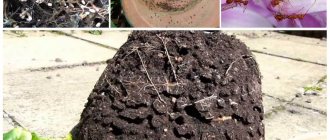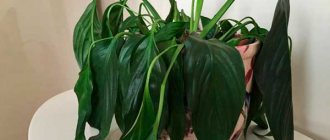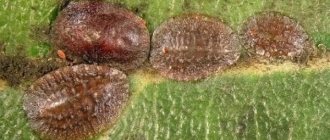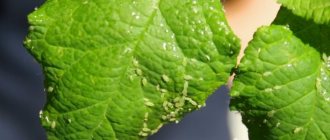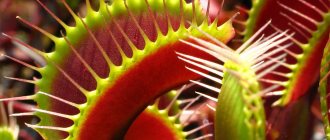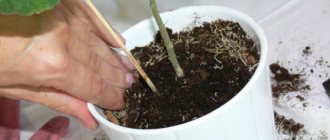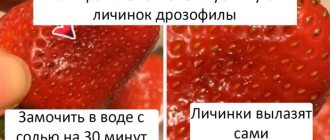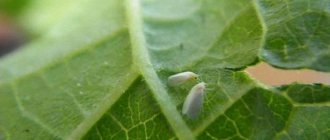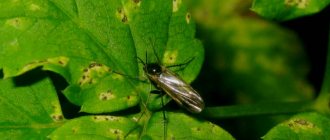You can remove ants that have settled in a flower pot or garden flower bed using various methods. For this purpose, baits can be used, made independently or purchased at a gardening supply store. Some gardeners dilute soap essence to destroy these pests. You can also prepare a drug based on a folk recipe.
It should be noted! The presence of ants on flowers indicates that there are pockets of aphids or worms in the planting pot. Aphids are destroyed with a special agent diluted in water, which is used to spray the flower. You can get rid of worms by transplanting the plant into a larger container.
About the causes
Ants on flowers
Factors contributing to the appearance of ant outbreaks in flower pots are:
- neglect of regular cleaning: an overfilled garbage bin, the presence of food remains on the table surface or on the floor can attract various insects, including ants;
- ant eggs or the pests themselves can be brought into a living space when they come into contact with clothing or shoes;
- insects such as ants prefer to choose warm habitats for themselves, which is the reason for their rush into human housing (if there is no hygiene in an apartment or house, this will be an ideal place for their spread);
- a colony of ants can move into a neighboring apartment if one of the neighbors decides to start removing them.
Note. When ants enter an apartment, they settle in an indoor flower pot, where the conditions for their habitat are most favorable.
Why is this happening
Before looking for ways to remove ants from a flower pot, you need to find the reason for their appearance. Experts have proven the close symbiosis between ants and aphids. The latter prefers to use plant juice as a food source. Indoor flowers in pots are the optimal habitat. It is always warm there, moderately humid and all the plants have enough juice.
Ants themselves are capable of growing entire colonies of aphids, carefully caring for their representatives. For these insects, the sweet honeydew, which is secreted during the life of aphids, becomes the most delicious morsel. As a result, large colonies of both aphids and ants grow in flower pots on the window.
Ants in indoor plants
Also, the reason that ants appeared in flower pots could be the initially contaminated soil. It is often imported by flower growers from the forest.
Important!
Before starting the fight, you should carefully study the behavior of insects and determine their location.
Ignoring the problem threatens the rapid death of your favorite potted plants. After all, after an aphid attack, decorative flowers quickly begin to fade, stop growing and may finally die
Friends or pests?
Ever since school, everyone knows that ants should not be destroyed, because they only bring benefits. To some extent, we can agree with this statement. In garden plots you can encounter two types of ants: red (pharaonic) and black. The favorite place that ants have chosen to build their homes is the garden and vegetable garden.
These tiny insects kill caterpillars and other pests. In places where ants have settled, the top layer of soil is saturated with nitrogen and humus. It would seem that there is no reason to fight them. But that's not true. In addition to positive aspects, they cause significant harm to trees, plants in greenhouses, vegetable gardens, and penetrate beehives. The biggest harm of ants is that they spread most of the fungal diseases known in gardening.
Multiple underground passages made by ants are located directly under the root system of crops, inhibit their growth, spread aphids, protect them and collect the sweet nectar that they secrete. It is known that ants even shelter aphids from the cold during the winter. If this pest has been noticed on plants, this is the first sign that it is time to take measures to eliminate ants and aphids. It is advisable to do this at the same time. Sometimes, ants move into human houses, causing a lot of inconvenience to their inhabitants.
Once a year, male ants flock to the nest. After mating, they soon die, and the female sheds her wings and leaves the habitat in search of new housing. As soon as a suitable place is found, she lays eggs, from which new offspring of ants will soon be hatched, and accordingly we should expect the appearance of another anthill in the garden or several at once.
Why do ants live in flowers?
Ants appear in indoor flowers for the following reasons:
- irregular cleaning: a full trash can, leftover food on the table and floor - these are the things that attract the attention of pests;
- ants or their eggs can be brought into the house on clothes or shoes from the street;
- due to the fact that these pests are heat-loving insects, with the arrival of cold weather they rush into human housing; the ideal conditions for their stay are in the absence of hygiene;
- insects may come from a neighboring apartment, the owners of which have decided to get rid of pests.
Ants in a flower pot Once in an apartment, ants will definitely take a liking to a flower pot and settle in it. After all, it is in it that favorable conditions are created for pests to live.
Ants in flower pots - how to get rid of them?
A good and environmentally friendly way to control insects is to spread sesame seeds around the plant. If you sprinkle sesame seeds on an anthill, the seeds of the plant become infected with a fungus. This helps to quickly get rid of the “womb” of insects.
However, this method is not entirely suitable for flower pots at home. Therefore, we offer you a simple and accessible method for which you will need:
- Large container or bath.
- Water.
- Plasticine.
- A plant in a pot with insects living there.
To get rid of ants in flower pots, follow these steps:
- Place the infested flower pot in a large container or tub filled with water. The pot itself must be completely filled and immersed in water.
- Leave the pot in the water for 30 minutes. During this time, the ants will either run away or drown.
Important! If the flower pot is too large and you cannot move it, then plug the drain hole with plasticine and water the pot very generously. Just as in the previous case, leave the plant for 30 minutes and then remove the plasticine.
- Remove old soil from the root system.
- Repot the plant using new soil.
Important! Remove soil with ants away from other indoor plants and dispose of it.
- Place the flower pot in its original place and make sure there is nothing nearby that might attract ants.
Important! Peretrum spray can help get rid of ants in a flower pot. The product must be used very carefully. First, dilute the peretrum spray with water (10 parts of the product to 90 parts of water), and then water the plant and leave it for 10 minutes to allow the water to drain.
Folk remedies for ants in the garden
There are a lot of traditional methods for destroying ant colonies. Moreover, they use affordable means that are found in every home. Here are some recipes.
Baking soda
Baking soda is poisonous to ants. The anthill is dug up and the area is generously sprinkled with soda. They do this several times. You can speed up the process by using powdered sugar, which will attract insects. It is mixed with soda, then the resulting product is scattered on the problem area.
Soda is also used in the form of an aqueous solution. 2-3 tbsp. spoons of powder are dissolved in 1.5 liters of water. Pour the solution onto the ant heap, sprinkle with earth, and cover with polyethylene. Other liquids work similarly: boiling water, warm lime.
Ash and soot
The technique described in pre-revolutionary publications is still used. Ash and soot are mixed in equal proportions. The resulting mass is spread in a thick layer in places where pests accumulate. A concentrated solution of salt is poured generously on top of everything. You can use ammonia diluted with water in a ratio of 1:100. It is good to add lime or ash to the solution.
How to remove ants from flower pots
How to remove ants from flower pots
There is a list of removal methods if ants appear on flowers and how to fight them:
- The widely used well-known folk method of flooding is carried out by placing a flower pot in a large, deep container, which must be filled with water. If your household equipment does not have a container of a suitable size, the pot is filled to the top with water. After a few minutes, when faced with flooding conditions, the pests will almost stop fussing;
- Work on replacing the soil must be carried out correctly: the pot is turned over and the flower is carefully removed from it. Next, the entire root system is thoroughly cleaned and washed to remove eggs laid by ants;
- The method of applying repellents is to treat the pot and trunk with garlic or vegetable oil.
- The list of herbs that repel ants includes:
- sagebrush;
- mint;
- lavender;
- anise;
- parsley;
- tomato tops;
- basil;
- cinnamon;
- carnation;
- black pepper;
- red pepper.
Herbs for ants
Insects cannot tolerate the smell of the above herbs, which forces them to look for a new habitat.
Helpful advice. If it is impossible to replace the contaminated soil, it must be calcined by placing it in a preheated oven for 20 minutes. The soil can be used for its intended purpose after cooling.
- You can also catch ants by covering a flower pot with tape so that the sticky side faces outward;
- A soap solution for killing ants is prepared from 1 teaspoon of liquid soap dissolved in 0.5 liters of water. The resulting liquid is poured into a spray bottle and used to treat the flower planting by spraying. In addition, it is recommended to pour a little solution into the soil;
- You can exterminate ants by placing a mixture of oatmeal and honey near the container with the flower. Honey is a strong-smelling component that attracts ants, oatmeal is a poisonous substance for these insects, and if they eat it, they will immediately die;
- When ant pockets appear in a flower pot, you can sprinkle the soil with millet. When eating cereal, the ants will die, since due to the swelling of the millet inside the insect, its body is deformed;
Note. The method of killing ants using millet is considered the most suitable for use in gardens.
- A solution of camphor oil for removal is prepared by diluting 10 drops of this essential component in 1 liter of warm water. The resulting liquid is used to water diseased flowers. The treatment should be repeated 3 times.
Fighting insects with various means and baits
Nowadays, in stores that sell flowers, on the market, or via the Internet, you can buy chemicals or buy traps that will help you get rid of uninvited guests - ants - at home.
Permethrin
This is a product that is used to treat the soil at home and outside.
Insects eat it, and their nervous system is affected. Insects die due to paralysis.
Permethrin can be purchased as an aerosol or powder.
Before applying the drug to a flower at home, carefully read the instructions. This product is harmful to humans. Do you want to protect yourself?
Wear gloves, make sure that the drug does not get on the mucous membranes of the mouth or eyes. Warn children that this is poison and should not be handled.
If by chance someone at home or even a pet swallows permethrin, rinse the mouth of the child, dog or cat, etc. with plenty of water. Go to a doctor or veterinarian immediately.
Lures
Using baits at home, you can destroy the entire colony. Most often, the bait contains proteins or sugar, tasty oil.
The insecticide must be poured into the bait. The block must be closed and placed on a windowsill or other place near the flower. Before using poison, read the label on it. This product should be safe for children and pets.
The bait helps remove parasites and contains active substances such as:
- boric acid;
- hydramethylnon;
- avermectin;
- fipronil.
Do you want to completely destroy all insects? Do not purchase baits with permethrin or cyfluthrin for home use. The poison in them is potent. Some worker ants will eat it and quickly die, and the colony will continue to develop.
Cover the soil with diatomite
Diatomite is an insecticide (organic) that has a mineral base.
Its consistency is similar to flour. They need to sprinkle the soil around the flower in the pot.
The worker insects will eat the diatomaceous earth and die within half an hour.
The substance can be wetted, but it will be less effective. After watering the flower, the appearance of dew or rain, the poison can be reused.
People should not inhale diatomaceous earth. You can wear a gauze bandage when working with it.
Diatomite is stored in a bag well packed. So it will not harm you, your household and animals.
Soap
To combat insects in an apartment, you will need 1 tbsp of mint soap. l. and 0.5 liters of water. The solution is poured into a spray bottle and the flower is sprayed with it.
In the bathroom, attach a hose to the faucet and use a water jet to wash off the ants from the leaves and stems. Garden flowers are treated similarly.
Sweet poison
Another effective way to get rid of pests in flower pots is to prepare a treat that can kill annoying ants. Millet and honey are used for this. It is necessary to mix the two ingredients and place them on a plate next to the infected plant. The sweet component of the product will definitely force insects to eat it, and the digestive system of six-legged animals is not able to digest the cereal. As a result, all individuals that have tasted the delicacy will die and the flowers will be able to fully grow and develop.
Water hazards made from old tires
The principle of operation is simple: a moat of water is created around the bush. No pests can cross it. Such a barrier is a reliable protection in cases where peonies are surrounded by ants.
Making a barrier is not difficult. Required:
- knife;
- old tires;
- water.
Procedure.
- Cut the tire lengthwise.
- Place one half on the bush.
- Place the tire on the ground, pit side down.
- Fill with water.
Such a barrier will not only prevent ants, aphids and other pests from appearing on peony flowers, but will also moisten the base of the plant.
Poisonous insect sprays
To save peonies from ants, you can spray the plant and the soil underneath with chemicals.
Yes, they can harm pets, birds and even humans, but if you choose the product wisely, you can avoid poisoning.
Another disadvantage of this method is that the ants will return very quickly. If you treat peonies with various chemicals, the effect will last until the first watering or rain.
Strength of smell
Ants have a fairly developed sense of smell to sense food over long distances. Therefore, if there are ants on flowers, you can use some plants.
On a note!
Ants cannot stand the smell of wormwood, mint, parsley and tomato tops. You can simply place these plants on the windowsills near flower pots, and the pests will quickly leave the occupied area.
Mint (Mentha sp.)
The most effective plants against ants are all types of mint. Especially peppermint (Mentha piperita) produces an extremely unpleasant odor for ants. The main role is played by menthol, which has an intoxicating effect on ants. Peppermint grows best in semi-shaded, moist areas.
It can be grown in pots on terraces and balconies, which will also protect these places from insect invasion. Despite its many benefits, mint does have a drawback. mint planted in a vegetable garden or garden grows very quickly thanks to underground rhizomes and can become an unpleasant weed in a short time.
That's why you need to keep an eye on its growth.
Tansy (Tanacetum vulgare)
The second plant that effectively repels ants from the garden is common tansy. Tansy is a wild plant that can be found in meadows near roads and fields. Previously, it was grown in gardens as an ornamental plant and herb.
Tansy - emits a strong, fragrant odor similar to camphor. From tansy we can also prepare liquid manure, infusions and extracts that will be useful in the garden to combat other pests (for example, aphids).
Just like mint, tansy is a very expansive plant and requires control.
Rosemary (Rosmarinus officinalis)
Plants for ants - rosemary, an indispensable assistant in the fight against insects. Rosemary produces a camphor-like aroma similar to pine, which effectively rids the garden of ants and other insects. Rosemary has many culinary uses.
Planted in a pot on the kitchen window it will discourage ants. It likes sunny and warm places, as well as light and permeable soils. Rosemary does not overwinter in our climate, so it is grown in gardens and vegetable gardens as an annual plant.
However, ant repellent plants grown in pots can overwinter in a room and keep you ant-free for many years.
Marjoram (Origanum majorana)
Marjoram is a very famous spice and herbal plant that will discourage ants from creating nests in its vicinity. Ants hate the smell of marjoram. It needs to be grown in a sunny, wind-protected place, in light and fertile soil.
You can plant it next to flower beds and with vegetables, especially brassica - an ornamental cabbage, for which this neighbor will bring a positive effect. You can also make an extract from marjoram that is used to apply to the trails of wandering ants. To prepare it, you must pour 10 g.
dried marjoram herb with 10 liters of water and let it stand for one day. It should be used immediately after preparation.
Thyme (Thymus vulgaris)
Thyme is a well-known medicinal plant and spice whose smell is not liked by ants. Thyme can reach a height of about 30 cm, has small leaves and small purple or white flowers.
You can plant it along paths, flowerbeds and beds, or plant it in pots that can be moved around. It produces a less intense odor than other ant repellent plants, but it is very effective.
Soil replacement
Replacing soil when infested with ants
This method is suitable if the pest has already lived in the soil being used:
- To get rid of it, you need to remove the flower along with the soil from the pot.
- Free the roots from soil as much as possible.
- Pour boiling water over the contaminated soil from the pot and allow to cool. In this case, all individuals die, including their eggs and larvae.
It is also possible to do it in another way so as not to disturb the plant too much. Place the flower pot in a large container of water so that the liquid completely covers it. Let it sit for a while. If there are ants in the ground, they will definitely try to escape. Since pests cannot swim, they will quickly die.
Important!
After the procedure, be sure to let the soil from the pot dry to avoid rotting of the root system.
Flood
If ants have attacked a flower, then to get rid of them, it is necessary to flood their home. To do this, place the flower pot in a deep, large-diameter container and fill it with water. If this is not possible, you should close the water outlet holes and fill the pot to the top with water. The bustle of insects will become noticeable within a few minutes.
Application of repellents
Treating the pot and stem of an indoor flower with garlic or vegetable oil will help remove ants. You can also place a sprig of wormwood, mint, lavender, anise or parsley in the place where pests accumulate. The smell of these plants is not to the liking of insects, which will force them to go in search of new housing. Tomato tops have similar properties.
The aroma of basil, cinnamon or cloves will repel ants from the flower. Insects are afraid of black and red ground pepper. It is enough to scatter any of these spices near the pot, and the ants will leave the flower forever.
Destruction of ants in flowers
Camphor oil
Camphor oil is another effective remedy against pests in the soil. It is enough to dilute 10 drops of camphor oil in 1 liter of warm water and pour the resulting solution over the infected flowers. To achieve maximum effect, the procedure is repeated 2-3 times.
On a note!
Regular cleaning of the apartment will help protect your indoor flower from pest invasion.
Tape traps
Regular tape will help reduce the number of ants at home. It is enough to paste it over the edges of the flower pot, as well as the flowerpot, with the sticky side facing out, and the insects scurrying here and there will certainly fall for this trick.
Special preparations
If there are ants in your indoor flowers, you can also fight them with targeted insecticides. The stores offer solutions that need to be used to treat the soil in pots. Poison sticks are also available. To use them, it is enough to insert an insecticide into the ground.
Special baits have proven themselves well. This is one of the most popular remedies. You can buy them in the store, or you can prepare them yourself. To do this, simply mix sugar, honey or other sweets with a small amount of boric acid. Roll into balls and place in ant paths.
Thus, the fight against ants in home flowers has positive results from the very beginning. The main thing is to take action as quickly as possible, before the population spreads and affects all domestic vegetation.
Kitchen products
To get rid of ants, you can use products that you probably find in your kitchen.
This could be coffee grounds, pepper and other products, or a homemade trap with self-adhesive film.
Coffee grounds
For some reason, ants really don't like coffee grounds. They will avoid her. To get rid of them, sprinkle it on the soil in the pot and around the pot. Soon the insects will leave.
Spices and products that are on hand
Some mothers worry whether various toxic insect repellents will harm their children? They are safe, just follow the precautions.
Despite this, some housewives prefer natural repellers in the apartment. These include:
- baking soda;
- cinnamon;
- carnation;
- mint;
- basil;
- chili pepper or black powder.
One or more of these products needs to be drawn in a circle around the flower pot. Seal the windows. Gradually, the insects will leave the flower, and new ones will not get into it.
Millet
If ants have settled in flower pots, then simply sprinkle millet on the ground. The cereal will clog the ant passages, which will force the insects to leave their nest. There is another opinion on the use of this recipe. Ants, eating cereals, die due to the fact that the millet begins to swell inside them, deforming the body of the pests.
This method is more often used to control pests in the garden, but it is also quite acceptable for indoor plants.
Oatmeal with honey
The fight against ants in home flowers can be carried out using oatmeal and honey. They are mixed in a 1:2 ratio, the resulting mass is laid out near the flower pot. Ants have a big sweet tooth, so the smell of honey will quickly attract their attention. But oatmeal acts as a poisonous component, and insects will die if they eat it.
Types of ants
Ants do not live separately; they can only exist within a colony. It includes:
- Adult females (queens). They are large in size and never leave the nest; their main mission is to lay eggs. There can be several queens in one nest. They live for about 10 months.
- Worker ants. These are ants whose task is to obtain food and deliver food for the queens, and to care for the laid larvae. They live for about 60 days.
DIY non-poisonous trap
You can make your own insect trap. It will be non-toxic from a self-adhesive film. Do it like this:
- cut out a self-adhesive ring of such a size that it tightly covers the flower pot;
- Remove the protective layer from the tape and place it with the sticky side facing out so that insects crawling past are caught in the trap. The pot will stand in the center of such a tape;
- The adhesive film should be changed when necessary.
Do you want ants to leave your home forever after treatment? Clean the kitchen thoroughly after meals, do not leave sweet jam, honey, fruit and other foods that attract insects.
Cover juices and compotes in jars with a nylon lid. Take out the trash regularly.
Disinfect and keep the apartment clean. New insects will not take root; using various means you can get rid of the old-timers.
Preventive measures against the appearance of ants
To prevent ants from appearing in your home again, take preventive measures:
- Pay close attention to the cleanliness of your kitchen. Do not leave dirty dishes and thoroughly wipe all work surfaces from food residues.
- Do not leave the following products open: sweets, meat, bread and other products.
- Store fruit in tightly closed food containers or the refrigerator.
- Frequently remove trash that may serve as a beacon for ant colonies in your kitchen.
- If you have determined the paths where the ants appear, then stick a 5 cm wide adhesive path using double-sided tape. This will deter the onslaught of uninvited guests.
- Keep juices and sweet drinks in closed plastic bottles.
- Sprinkle soda, black or red hot pepper near the doors, as well as on the window sills. This will repel insects.
- Ants also cannot tolerate the smell of cinnamon, basil, mint and cloves (spices). If you place repellent folk remedies around the room or on the windowsill, the ants will smell them and will not return to your house.
- Seal your windows and sprinkle your window sill with deterrents to prevent them from sneaking in through your window.
